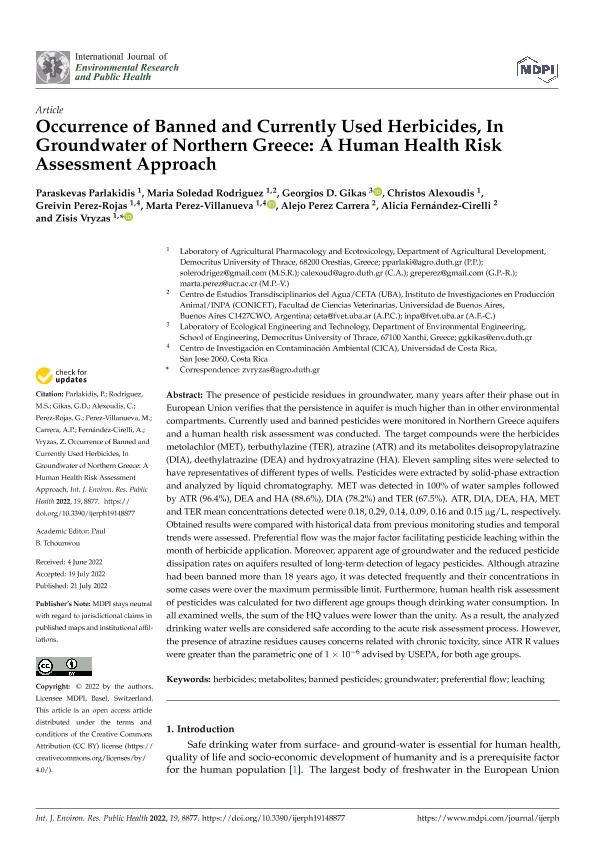Artículo
Occurrence of Banned and Currently Used Herbicides, In Groundwater of Northern Greece: A Human Health Risk Assessment Approach
Parlakidis, Paraskevas; Rodriguez, Maria Soledad ; Gikas, Georgios D.; Alexoudis, Christos; Perez Rojas, Greivin; Perez Villanueva, Marta; Pérez Carrera, Alejo Leopoldo
; Gikas, Georgios D.; Alexoudis, Christos; Perez Rojas, Greivin; Perez Villanueva, Marta; Pérez Carrera, Alejo Leopoldo ; Fernandez Cirelli, Alicia
; Fernandez Cirelli, Alicia ; Vryzas, Zisis
; Vryzas, Zisis
 ; Gikas, Georgios D.; Alexoudis, Christos; Perez Rojas, Greivin; Perez Villanueva, Marta; Pérez Carrera, Alejo Leopoldo
; Gikas, Georgios D.; Alexoudis, Christos; Perez Rojas, Greivin; Perez Villanueva, Marta; Pérez Carrera, Alejo Leopoldo ; Fernandez Cirelli, Alicia
; Fernandez Cirelli, Alicia ; Vryzas, Zisis
; Vryzas, Zisis
Fecha de publicación:
21/07/2022
Editorial:
MDPI
Revista:
International Journal of Environmental Research and Public Health
ISSN:
1660-4601
Idioma:
Inglés
Tipo de recurso:
Artículo publicado
Clasificación temática:
Resumen
The presence of pesticide residues in groundwater, many years after their phase out in European Union verifies that the persistence in aquifer is much higher than in other environmental compartments. Currently used and banned pesticides were monitored in Northern Greece aquifers and a human health risk assessment was conducted. The target compounds were the herbicides metolachlor (MET), terbuthylazine (TER), atrazine (ATR) and its metabolites deisopropylatrazine (DIA), deethylatrazine (DEA) and hydroxyatrazine (HA). Eleven sampling sites were selected to have representatives of different types of wells. Pesticides were extracted by solid-phase extraction and analyzed by liquid chromatography. MET was detected in 100% of water samples followed by ATR (96.4%), DEA and HA (88.6%), DIA (78.2%) and TER (67.5%). ATR, DIA, DEA, HA, MET and TER mean concentrations detected were 0.18, 0.29, 0.14, 0.09, 0.16 and 0.15 μg/L, respectively. Obtained results were compared with historical data from previous monitoring studies and temporal trends were assessed. Preferential flow was the major factor facilitating pesticide leaching within the month of herbicide application. Moreover, apparent age of groundwater and the reduced pesticide dissipation rates on aquifers resulted of long-term detection of legacy pesticides. Although atrazine had been banned more than 18 years ago, it was detected frequently and their concentrations in some cases were over the maximum permissible limit. Furthermore, human health risk assessment of pesticides was calculated for two different age groups though drinking water consumption. In all examined wells, the sum of the HQ values were lower than the unity. As a result, the analyzed drinking water wells are considered safe according to the acute risk assessment process. However, the presence of atrazine residues causes concerns related with chronic toxicity, since ATR R values were greater than the parametric one of 1 × 10−6 advised by USEPA, for both age groups.
Palabras clave:
BANNED PESTICIDES
,
GROUNDWATER
,
HERBICIDES
,
LEACHING
,
METABOLITES
,
PREFERENTIAL FLOW
Archivos asociados
Licencia
Identificadores
Colecciones
Articulos(INPA)
Articulos de UNIDAD EJECUTORA DE INVESTIGACIONES EN PRODUCCION ANIMAL
Articulos de UNIDAD EJECUTORA DE INVESTIGACIONES EN PRODUCCION ANIMAL
Citación
Parlakidis, Paraskevas; Rodriguez, Maria Soledad; Gikas, Georgios D.; Alexoudis, Christos; Perez Rojas, Greivin; et al.; Occurrence of Banned and Currently Used Herbicides, In Groundwater of Northern Greece: A Human Health Risk Assessment Approach; MDPI; International Journal of Environmental Research and Public Health; 19; 14; 21-7-2022; 1-16
Compartir
Altmétricas



